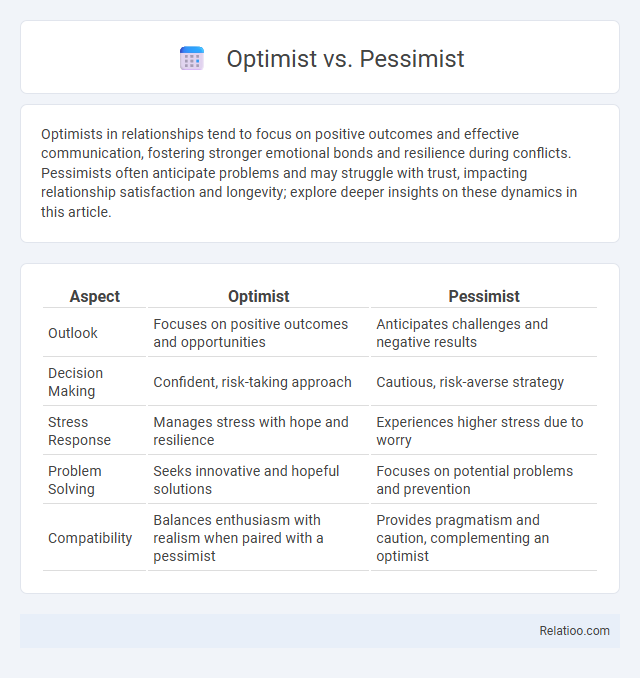Optimists in relationships tend to focus on positive outcomes and effective communication, fostering stronger emotional bonds and resilience during conflicts. Pessimists often anticipate problems and may struggle with trust, impacting relationship satisfaction and longevity; explore deeper insights on these dynamics in this article.
Table of Comparison
| Aspect | Optimist | Pessimist |
|---|---|---|
| Outlook | Focuses on positive outcomes and opportunities | Anticipates challenges and negative results |
| Decision Making | Confident, risk-taking approach | Cautious, risk-averse strategy |
| Stress Response | Manages stress with hope and resilience | Experiences higher stress due to worry |
| Problem Solving | Seeks innovative and hopeful solutions | Focuses on potential problems and prevention |
| Compatibility | Balances enthusiasm with realism when paired with a pessimist | Provides pragmatism and caution, complementing an optimist |
Defining Optimism and Pessimism
Optimism is defined by a positive outlook where individuals expect favorable outcomes and view challenges as opportunities for growth, while pessimism involves anticipating negative results and focusing on potential obstacles or failures. Your mindset influences how you react to conflict triggers, with optimists tending to approach disagreements constructively and pessimists often perceiving conflict as threatening or insurmountable. Understanding these psychological perspectives helps in managing emotions and promoting effective communication during conflicts.
Core Traits of Optimists
Optimists typically possess core traits such as resilience, positive expectations, and proactive problem-solving, which enable them to approach challenges with confidence and hope. Unlike pessimists who anticipate negative outcomes and often experience heightened stress, optimists maintain a constructive outlook that fosters motivation and better mental health. Your ability to focus on solutions rather than setbacks helps reduce conflict triggers, promoting smoother interpersonal interactions and effective conflict resolution.
Key Characteristics of Pessimists
Pessimists often anticipate negative outcomes and focus on potential problems, which can lead to increased stress and reluctance to take risks. Their key characteristics include a tendency to expect failure, interpret situations with a negative bias, and feel helpless in the face of challenges. Understanding these traits can help you manage conflicts by recognizing how a pessimist's mindset might trigger misunderstandings or defensive reactions.
Psychological Impact of Optimism vs Pessimism
Optimism fosters resilience by promoting positive expectations, reducing stress levels, and enhancing overall mental health, while pessimism heightens vulnerability to anxiety, depression, and cognitive distortions. Research in psychology indicates that optimistic individuals employ more effective coping strategies, leading to improved problem-solving during conflicts and interpersonal challenges. Conversely, pessimistic mindsets often trigger conflict sensitivity through negative bias and emotional reactivity, impairing relationship dynamics and increasing psychological distress.
Effects on Physical Health and Wellbeing
Optimists tend to experience lower levels of stress hormones, which supports better cardiovascular health and stronger immune function, whereas pessimists often exhibit higher inflammation and increased risk for chronic illnesses due to prolonged stress exposure. Chronic conflict triggers can exacerbate negative health outcomes by elevating cortisol levels, leading to weakened immune responses and heightened vulnerability to mental health disorders like anxiety and depression. The interplay between optimism, pessimism, and conflict-related stress significantly influences overall physical health and wellbeing through neuroendocrine and inflammatory pathways.
Optimist and Pessimist Mindset in Relationships
Optimists view conflicts as opportunities for growth and understanding, fostering healthier communication and stronger bonds in relationships. Pessimists tend to perceive conflicts as threats, often escalating tension and hindering resolution. Your mindset directly shapes how you navigate disagreements, influencing overall relationship satisfaction and emotional resilience.
Decision-Making: Optimistic vs Pessimistic Approaches
Optimistic decision-making emphasizes potential gains and positive outcomes, driving individuals to take risks and pursue innovative solutions, while pessimistic decision-making focuses on possible losses and risks, promoting cautious and preventive measures. Conflict triggers often arise when optimistic approaches clash with pessimistic perspectives, creating tension between risk-taking and risk-avoidance strategies in team environments. Understanding these contrasting mindsets enhances conflict resolution by balancing aspirational goals with realistic assessments in decision-making processes.
Influence on Career Success and Productivity
Optimists generally exhibit higher career success and productivity due to their positive mindset, resilience, and proactive problem-solving approach. Pessimists often face challenges in professional growth as their negative expectations can lead to decreased motivation and increased stress, which hampers productivity. Conflict triggers, such as poor communication and differing values, can significantly disrupt team dynamics, reducing overall efficiency and career advancement opportunities.
Strategies to Cultivate a Balanced Perspective
Cultivating a balanced perspective involves recognizing the cognitive biases of both optimists, who may overlook potential risks, and pessimists, who might focus excessively on negatives, by integrating realistic assessments and adaptive thinking strategies. Employ mindfulness techniques and cognitive reframing to reduce conflict triggers that arise from rigid outlooks, promoting emotional regulation and open communication. Employing data-driven decision-making tools can help maintain equilibrium between hopefulness and caution, enhancing problem-solving and resilience in challenging situations.
Embracing Both Perspectives for Personal Growth
Embracing both optimist and pessimist perspectives allows you to navigate conflict triggers with balanced insight, recognizing opportunities and risks simultaneously. By integrating optimism's hopefulness and pessimism's caution, you can foster resilience, improve decision-making, and promote emotional intelligence. This dual approach enhances your personal growth by transforming conflicts into valuable learning experiences.

Infographic: Optimist vs Pessimist
 relatioo.com
relatioo.com